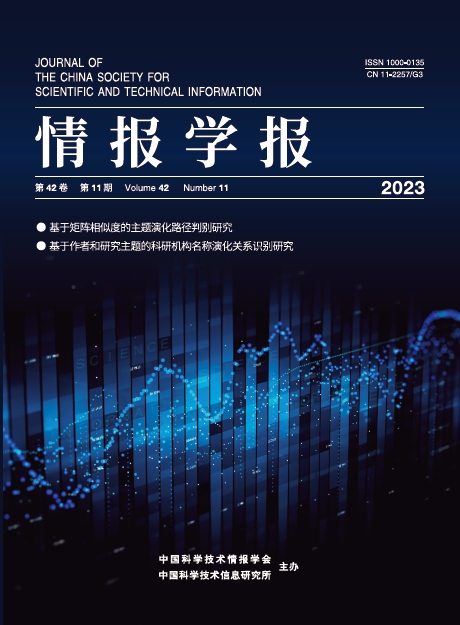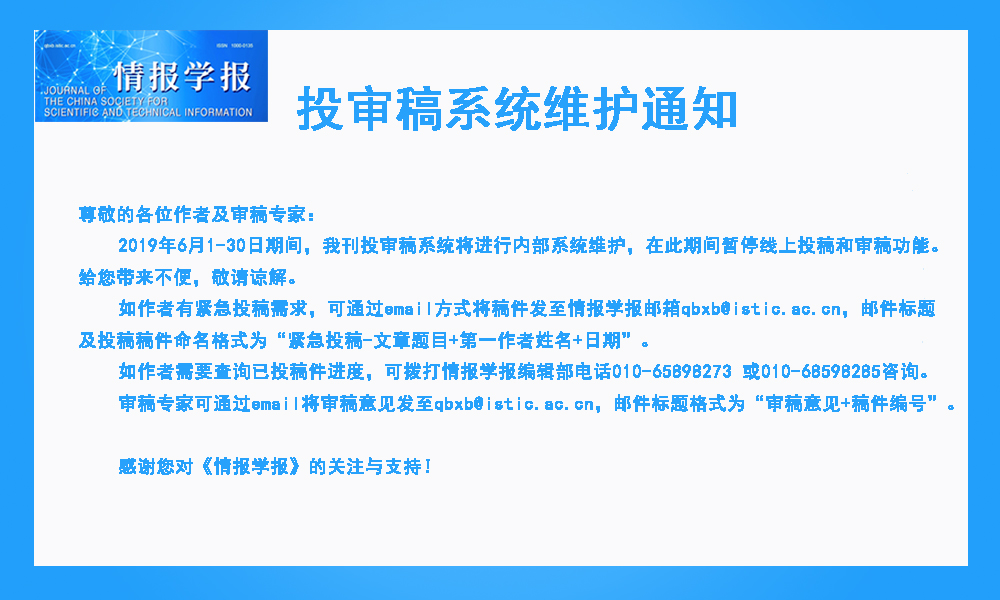 |
|
|
|
|
|
| Intelligence Theories and Methods |
|
|
1265 |
Identifying Research Topic Evolutionary Paths Based on Matrix Similarity Hot! |
|
 |
Huang Han, Wang Xiaoguang, He Jing, Wang Hongyu |
|
|
DOI: 10.3772/j.issn.1000-0135.2023.11.001 |
|
|
The evolution of research topics is critical for clarifying scientific development and predicting frontiers. The calculation of the similarity of topics in adjacent time periods and identification of their evolutionary paths is the core step in the topic evolution analysis. In this study, the matrix similarity algorithm is innovatively proposed to identify the topic evolution path. Based on the local network structure of the research topic in the co-word network, the similarity of the research topic in terms of words and relations is considered in the calculation of topic similarity. Subsequently, an analytical framework for research topic evolution based on matrix similarity is constructed. Considering piecewise linear representation, the framework divides the data into time periods to build the temporal co-word networks. After identifying the topic communities in the co-word network at each time period using the community discovery algorithm, multi-dimensional feature indexes such as novelty, popularity, core, and maturity are calculated to represent the types of research topics. The evolutionary paths of the research topics are then identified using matrix similarity calculations. Finally, the evolution process of the research topics is visualized by a Sankey diagram and a multi-dimensional strategic coordinate plot. Specifically, this study uses the field of library and information science as an example of empirical analysis. The results show that the proposed method can effectively support the evolution analysis of research topics in a research area and provide methodological support for research decision-making. |
|
|
2023 Vol. 42 (11): 1265-1275
[Abstract]
(
274
)
HTML
(157 KB)
PDF
(4944 KB)
(
603
) |
|
|
|
1276 |
Features and Awakening of Sleeping Beauties Based on Altmetrics Hot! |
|
 |
Xiang Fei, Cao Guang, Shen Tong, Chen Huafang |
|
|
DOI: 10.3772/j.issn.1000-0135.2023.11.002 |
|
|
It has been shown that Altmetrics-based “sleeping beauties” (A-SBs) are of great value. After developing methods to identify A-SBs, we must analyze the features, sleep causes, and awakening laws of A-SBs to realize their early prediction. This research considered the articles with the top 1% of attention as its experimental data and ASB index as the identification method. To explore the literature features and awakening laws of A-SBs, this research took the 10 articles with the highest ASB values as representative A-SBs and analyzed their features and attention accumulation processes in detail. The content of A-SBs is of high quality and can be divided into two categories, innovation and classic, and their topics frequently appear in daily life. Non-open-access or non-funded articles are more likely to become A-SBs. With complex content that is beyond the knowledge level of the general public, an article has more possibilities to fall asleep. The reasons for A-SBs being awakened include (1) improvement of the public’s knowledge, (2) encountering similar problems, (3) related public events, and (4) influential account recommendations. For the early prediction of A-SBs, it is helpful to pay more attention to innovative or classic articles, articles that gained attention on Patent or Wikipedia, non-open access articles, or non-funded articles. Scholars who use social media play an important role in realizing the early prediction of A-SBs. |
|
|
2023 Vol. 42 (11): 1276-1288
[Abstract]
(
190
)
HTML
(157 KB)
PDF
(1488 KB)
(
298
) |
|
|
|
1309 |
Impact of Top Scholars' Research Dynamics on Discipline Development Hot! |
|
 |
Tao Wenqian, Pan Yuntao, Wang Haiyan |
|
|
DOI: 10.3772/j.issn.1000-0135.2023.11.005 |
|
|
This study explored the relationship between the research dynamics of top scholars and the development of a discipline, to understand their influence, explore the regularity in iteration of scientific knowledge, and obtain insights for optimizing talent evaluation. We developed a quantitative model that focused on top scholars in a discipline, utilizing three dimensions (time, topic, and influence relationships) for the basic indicators. We combined this with the development life cycle of topic popularity, defined the types of influence that scholars have on the development of the discipline, constructed scholars’ impact functions, and analyzed the degree of impact of top scholars’ research on the development of the discipline. Based on empirical research in the field of gene editing, the most significant impact of top scholars on the development of the discipline was seen in the promotion of the third-generation gene editing technology CRISPR (clustered regularly interspaced short palindromic repeats) to become the most mainstream research topic, thereby achieving technological innovation. Compared to all scholars, top scholars played a prominent role in pioneering innovation and supporting other scholars and maintained advantages as the field continued to develop. We also analyzed the research dynamics of two typical scholars’ impact on the development of their discipline and identified two distinct impact patterns: the promoting pattern and the pattern that is a combination of pioneering, guiding, and supporting. The computed results are consistent with reality, which verifies the reliability of the constructed model. |
|
|
2023 Vol. 42 (11): 1309-1320
[Abstract]
(
265
)
HTML
(150 KB)
PDF
(2542 KB)
(
200
) |
|
|
|
1321 |
Relationship between University Patents Transformation with Inventor Team Characteristics Hot! |
|
 |
Li Rui, Luo Shuang, Kang Xinyu |
|
|
DOI: 10.3772/j.issn.1000-0135.2023.11.006 |
|
|
There is a sharp contrast between the high number of patent applications and the low commercialization rate of universities in China. Through an empirical study of patents successfully commercialized by 25 universities, this paper finds that, first, inventor team sizes for commercialized patents have an inverted U-shaped distribution, and four-person teams perform best. Second, university-enterprise collaborative teams of multi-source inventors are not conducive to patent transformation. Third, there is no positive correlation between team members’ invention experience and patent commercialization. Finally, the multiple knowledge structures of the team are not conducive to patent conversion, but a single centralized knowledge structure is more advantageous. This paper uses the theory of team conflict, sticky information, and endowment effect to make attributions to the research results and puts forward corresponding suggestions for university research management. |
|
|
2023 Vol. 42 (11): 1321-1334
[Abstract]
(
221
)
HTML
(218 KB)
PDF
(1692 KB)
(
273
) |
|
|
| Intelligence Technology and Application |
|
|
1335 |
Potential Scientific Collaborator Recommendation Model Utilizing Dynamic Research Interest and Social Trust Hot! |
|
 |
Zhong Yuansheng, Gao Chengzhen, Zhu Wenqiang |
|
|
DOI: 10.3772/j.issn.1000-0135.2023.11.007 |
|
|
Discovering potential collaborators automatically from massive data is a hot topic in scientific collaboration prediction. Considering that research interests change over time and people with social relationships are more likely to collaborate, a potential scientific collaborator recommendation model “SimTrustRec” is proposed, which integrates dynamic research interest and academic social trust. First, the Latent Dirichlet Allocation model is used to learn the topic distribution of published papers, and dynamic research interests of scholars are mined to calculate the similarity of research interests between two scholars. Second, an academic social network is constructed based on the co-occurrence relationship of scholars and units in papers. Direct academic social trust values are calculated and indirect academic social trust values are then calculated based on the transitivity of social trust. Finally, the possibility of potential collaboration between two scholars is calculated by combining research interest similarity and academic social trust value, and a list of potential collaborators is generated. Experimental results using ArnetMiner datasets demonstrate that the proposed method achieves better performance in terms of recall, hit rate, and mean reciprocal rank compared to existing methods. |
|
|
2023 Vol. 42 (11): 1335-1346
[Abstract]
(
201
)
HTML
(200 KB)
PDF
(2529 KB)
(
271
) |
|
|
|
1358 |
A Method of Search Term Recommendation Based on Dependency Syntactic Network Combined with PageRank Hot! |
|
 |
Lou Wen, Ma Xinyu, Su Zilong |
|
|
DOI: 10.3772/j.issn.1000-0135.2023.11.009 |
|
|
Facing increasing information overload and the rise of cross-cutting research, studies on the filtering ability of the information retrieval system to provide effective search term recommendation services are becoming increasingly important. This study proposes a search term recommendation method that integrates dependent syntax and language network theories using the PageRank algorithm. By constructing a search term set and dependent syntax network, and sorting the search terms using the PageRank algorithm, the search term recommendation is realized. The method is validated using the Web of Science platform 124,516 literature abstracts in the field of information science & library science as an example. We also invited ten MLIS graduate students to participate in the user study, which combined the comparison results with similar methods and systems. The results show that the accuracy of the recommended method is 80%, average Cosine similarity in the recommendation list is 0.53, and average Jaccard similarity in the table is 0.39. Compared with other methods and systems, the diversity of our approach reacts better with a higher degree of surprise. Overall, the results show that our method increased the coverage of the search terms based on the user’s information requirements. Our method is expected to provide references on methodological perspectives on the representation of information retrieval. It can be directly applied for terminological organization in the back end of information retrieval, as well as indirectly for knowledge discovery and inter-disciplinary study. |
|
|
2023 Vol. 42 (11): 1358-1368
[Abstract]
(
207
)
HTML
(135 KB)
PDF
(2512 KB)
(
358
) |
|
|
| Intelligence Users and Behavior |
|
|
1382 |
User Engagement Behaviors Based on the Consistency between Online Reviews and Management Responses Hot! |
|
 |
Zhu Linlin, Li He, Shen Wang, Liu Jincheng |
|
|
DOI: 10.3772/j.issn.1000-0135.2023.11.011 |
|
|
In addition to online customer reviews, management responses have become an essential dual-channel communication for customers to obtain related information online. Customer reviews and management responses can influence the engagement behaviors of prospective customers; however, this internal mechanism remains unclear. Therefore, this study aimed to combine each customer review with its corresponding management response to explore whether impacts subsequent customer engagement behaviors. Based on cognitive consistency theory, this study devised a research model for revealing the effect of both the topic and length consistency of each combination of reviews and responses on customer engagement, including review and response likes. An empirical study was conducted utilizing data collected from Huawei Mall with 80,329 combinations of reviews and responses. The topic and length consistency were measured using the Bidirectional Encoder Representations from Transformers (BERT) technique and cosine similarity, and text mining, respectively. A zero-inflated negative binomial model was applied for regression analysis. The results indicate that both consistencies of the customer reviews and management responses positively impact customer engagement behaviors. Moreover, review sentiment positively moderates the impact of the length consistency on response likes. The results of this study contribute to identifying matches of reviews and responses to predict future customer engagement behaviors. This assists practitioners in formulating management response strategies using the matching effect between reviews and responses to attract potential customers. |
|
|
2023 Vol. 42 (11): 1382-1394
[Abstract]
(
216
)
HTML
(172 KB)
PDF
(1140 KB)
(
513
) |
|
|
|


